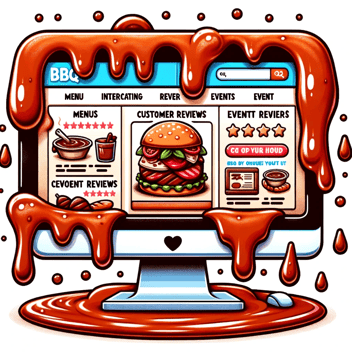From Dough to Digital: Navigating the Online Ordering Experience
This post may contain affiliate links, which means I may receive a commission if you click a link and purchase something that I have recommended. Thank you!
The digital age has not only changed how we communicate and interact but also how we order our favorite slice of pizza. Pizzerias are now embracing online ordering systems to cater to the tech-savvy customer who values convenience and efficiency. Transitioning from traditional ordering to a digital platform might seem daunting at first, but with the right approach, it can be a piece of cake... or in this case, a piece of pizza. This article will guide you through the process of navigating the online ordering experience, ensuring that your pizzeria stays hot in the digital realm.
Understanding the Transition from Traditional to Online Ordering
The first step in transitioning to an online ordering system is understanding the benefits and challenges involved.
Benefits
- Convenience: Customers can order at the click of a button without having to wait in long lines.
- Increased Sales: Online orders are typically 20% larger than in-store orders.
- Better Order Accuracy: Digital ordering reduces the chances of miscommunication.
Challenges
- Technical Glitches: Technical issues can disrupt the ordering process.
- Initial Setup Costs: Setting up an online ordering system requires an initial investment.
Embracing the online realm allows pizzerias to extend their reach beyond the physical location, offering a convenient solution for customers to satisfy their pizza cravings. By overcoming the initial hurdles, pizzerias can reap the benefits of increased sales and customer satisfaction.
The Importance of a User-Friendly Online Ordering Experience
A user-friendly online ordering experience is essential for attracting and retaining customers. According to a study, 70% of customers prefer to order directly from a restaurant's website rather than using third-party platforms1.
Key Features for a User-Friendly Experience
- Ease of Navigation: Customers should find it easy to browse the menu and select their preferred items.
- Clear Pricing: All prices should be clearly indicated to avoid any confusion.
- Accessible: The online ordering platform should be accessible on various devices including mobile phones, tablets, and computers.
The easier it is for customers to place orders, the more likely they are to return, boosting sales and enhancing customer satisfaction.
Key Components of an Online Ordering System
An efficient online ordering system comprises several key components that ensure a smooth ordering process from start to finish23.
Menu Display and Navigation
- Visual Appeal: Include high-resolution images of the menu items.
- Categories: Categorize the menu into sections like appetizers, mains, desserts, etc.
Shopping Cart Functionality
- Item Modification: Allow customers to customize their orders.
- Real-Time Updates: Provide real-time updates on the total cost as customers add or remove items.
Checkout Process and Payment Options
- Secure Payment Gateways: Ensure the security of customer's payment information.
- Multiple Payment Options: Offer various payment options like credit cards, digital wallets, etc.
Setting up the core components correctly is crucial for the success of the online ordering system.
Initial Steps in Setting Up an Online Ordering System
Setting up an online ordering system requires careful consideration and the right platform to ensure a seamless transition from dough to digital.
Choosing the Right Platform
- Features: Look for platforms that offer essential features like menu customization, real-time order tracking, etc.
- Integration: Ensure the platform can be easily integrated into your existing website and POS system.
Incorporating the Online Ordering System
- Website Integration: Incorporate the online ordering system into your existing website.
- Testing: Conduct thorough testing to ensure everything runs smoothly before going live.
The initial setup is a crucial phase that lays the foundation for a successful online ordering experience. By choosing the right platform and ensuring smooth integration, pizzerias can set the stage for a seamless digital ordering experience.
Designing the Online Ordering Experience
A well-designed online ordering experience is crucial for ensuring customer satisfaction and encouraging repeat business. From the layout to the navigation, every element plays a role in guiding the customer through the ordering process seamlessly.
Wireframing the Ordering Process
- Storyboarding: Plan out the customer's journey from landing on the menu page to completing the order.
- Feedback Loops: Include feedback mechanisms such as confirmation messages to guide customers through the ordering process.
Maintaining a Clean and Consistent Design
- Branding: Ensure your online ordering platform reflects your pizzeria's branding, including colors, fonts, and logos.
- Simplicity: Keep the design simple and uncluttered to avoid overwhelming the customer.
Making the Online Ordering Menu Easy to Find and Navigate
- Visibility: Ensure the online ordering option is prominently displayed on your website.
- Search Functionality: Include a search bar to help customers find specific items quickly1.
Optimizing Menu Listings
Presenting your menu in an organized and attractive manner can significantly enhance the customer's ordering experience.
Categorizing Menu Items
- Logical Grouping: Group similar items together, such as appetizers, mains, and desserts.
- Subcategories: Utilize subcategories for additional organization, like separating vegetarian and non-vegetarian pizzas.
Providing Clear and Concise Descriptions
- Informative Descriptions: Include brief yet descriptive text for each menu item, highlighting key ingredients and flavors.
- Allergy Information: Provide allergy information to cater to customers with dietary restrictions.
Including Images of Menu Items
- High-Quality Images: Include appealing images of the dishes to entice customers.
- Consistent Styling: Ensure images are styled consistently to maintain a professional look.
Special Offers and Add-Ons
Special offers and add-ons are excellent tools for upselling and enhancing the customer's order.
Creating Specials and Combo Deals
- Discounted Combos: Offer combo deals for popular items at a discounted rate.
- Daily Specials: Showcase daily or weekly specials to entice customers to try new items1.
Suggesting Add-Ons
- Suggested Items: Suggest additional items like extra toppings or side dishes as customers navigate through the menu.
- Bundle Deals: Create bundle deals to encourage customers to order additional items at a reduced price.
Smooth Checkout Process
A smooth checkout process is the final step in securing a successful online order.
Providing Multiple Sign-In Options
- Guest Checkout: Allow customers to check out as guests for a quicker process.
- Account Creation: Offer the option for customers to create an account for faster checkout in the future2.
Ensuring a Smooth and Intuitive Checkout Process
- Payment Options: Provide multiple payment options to cater to all customers.
- Order Summary: Include an order summary page for customers to review their order before finalizing.
Loyalty Programs and Seasonal Discounts
Loyalty programs and seasonal discounts are effective strategies for encouraging repeat business and attracting new customers.
Setting Up Loyalty Programs
- Reward Points: Offer points for each order that can be redeemed for discounts on future orders.
- Membership Levels: Create different membership levels with increasing benefits to encourage more frequent orders.
Offering Seasonal Discounts
- Holiday Specials: Offer special discounts during holidays or local events to attract more customers.
Receiving and Acting on Customer Feedback
Customer feedback is invaluable for the continuous improvement of the online ordering experience.
Being Open to Feedback
- Customer Surveys: Conduct surveys to gather feedback on the online ordering experience.
- Review Platforms: Monitor review platforms to address any negative reviews professionally.
Utilizing Customer Feedback
- Improvement: Use the feedback to make necessary adjustments to the online ordering system.
- Innovation: Use constructive feedback as a tool for innovation to enhance the customer experience


